
In 1982, Argentina and the United Kingdom fought one another in the South Atlantic in a war that briefly thrust the political fate of the Falkland Islands into the international spotlight. This 74-day long conflict is best remembered for its dramatic air, sea and land campaign—for Harriers, Exocet missiles, sinking warships and the final ground assault on the port city of Stanley. What has largely been forgotten though is that a second theater of operations was an important part of the Falklands War. This theater was 900 miles to the east of Stanley at the island of South Georgia, and it was the scene of a battle that pitted 22 Royal Marines against an Argentine naval task force. This battle was fought at the former whaling station of Grytviken, and it stands out as a unique episode in military history--one in which a sniper took on a warship.

After its discovery by British merchant Anthony de la Roché in 1675, England ultimately claimed South Georgia as an outpost of its vast oceanic empire in 1775. During the first two decades of the 20th century, six whaling stations were established on South Georgia's north coast in coves and bays that provided protection from the unrelenting Antarctic weather that scours the south coast. The island soon became the world's largest whaling center and its human population expanded dramatically. But Argentina considers South Georgia part of its overseas territory, refusing to acknowledge Britain's sovereignty over the island. In 1927 Buenos Aires began officially claiming it under the name Isla San Pedro and the Falklands under the name Islas Malvinas, but no direct confrontation over the matter emerged during more than three decades. The ownership issue started to become more and more of a controversy after whaling activity on South Georgia ended once and for all in 1965. By 1982, South Georgia’s six whaling stations were crumbling ghost towns that reminded the modern era of a time when whale oil was one of the most valued commodities in the world.

It was in this climate of rusting metal and competing territorial claims that an Argentine salvage party landed on South Georgia on March 19, 1982, at the former whaling station of Leith. The scrap workers had been carried to South Georgia on board the ship Bahia Buen Suceso, an Argentine naval transport chartered by a businessman named Constantino Davidoff. Although Davidoff had obtained permission to scrap the buildings and equipment at Leith, that permission required the expedition to check-in with British authorities at the official port of entry on South Georgia: the village of Grytviken.

There, the British Antarctic Survey maintained a modest base of operations at King Edward Point near the ruins of another of the island’s abandoned whaling stations. This facility was under the direction of a base commander, who also functioned as the island’s magistrate, and was, therefore, designated by the crown to issue landing permits to visiting ships. But when the Bahia Buen Suceso reached South Georgia on March 19, it proceeded directly to Leith without stopping at Grytviken to check in. Once there, a work detail went ashore and began dismantling the whaling station—but they were not alone. The ship’s detachment of 50 uniformed Argentine Marines also went ashore, raised an Argentine flag, and started a little target practice with their rifles. They even shot one of the island’s reindeer, dressed it, and started grilling steaks.
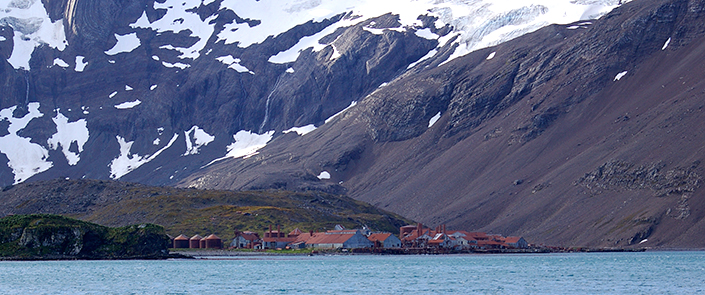
The noise of the gunshots quickly attracted the attention of a small group of researchers from the British Antarctic Survey station that just so happened to be moving supplies to Leith that same day in preparation for the coming winter. They quickly reported the Argentine landings at Leith Harbour to the governor at Stanley in the Falklands, who then passed on the report to London. Within 16 hours, the Magistrate at Grytviken had received a message to present to the Argentine commander:
“You have landed illegally at Leith without obtaining proper clearance. You and your party must go back on board the Bahia Buen Suceso immediately and report to the Base Commander at Grytviken for further instructions. You must remove the Argentine flag from Leith. No military personnel are allowed to land on South Georgia. No firearms are to be taken ashore.”

Although the captain of Bahia Buen Suceso did ultimately take down the Argentine flag, he did not proceed to Grytviken as instructed, and the intruders kept at their salvage work at Leith. When the ship’s non-compliance was reported to London, the British government immediately lodged an official protest with the government in Buenos Aires. For the Argentine military junta led by General Leopoldo Galtieri, ownership of South Georgia was equal in weight to ownership of the Falkland Islands, so the two claims soon merged into one unstoppable cause célèbre. At the time, Argentina’s domestic reality was deeply troubled, and the territorial dispute with England offered an opportunity to distract the people from their political and economic despair. Galtieri and the junta did not miss a beat and immediately began stirring-up some good old-fashioned irredentism.
The increasingly strident tone of the Argentine rhetoric was enough of a cause for concern that London took the precaution of dispatching a ship to South Georgia--the icebreaker HMS Endurance. The only Royal Navy vessel in the South Atlantic at the time, HMS Endurance departed the Falklands on March 21 with a detachment of 22 Royal Marines aboard. They were under the command of Lt. Keith Paul Mills, a 22-year old junior officer with four years of service and a tour of duty in Northern Ireland.

When the ship reached South Georgia on March 25, they found that Bahia Buen Suceso was no longer there—it had departed on March 21. However, in its place was the Argentine Navy’s Antarctic exploration ship Bahia Paraiso. The Royal Marines placed Leith Harbor under covert surveillance long enough to confirm that uniformed military members remained ashore there. With that, Endurance proceeded to Grytviken and landed Lt. Mills and his men at the British Antarctic Survey station. As Endurance sailed away, the Royal Marines moved in to the station’s dormitory Shackleton House, and immediately began preparing fighting positions in the tussock grass on a narrow plateau overlooking King Edward Point. They also placed land mines on the beach.
In the days that followed, as confrontation loomed over the South Atlantic, Argentine public enthusiasm for some kind of aggressive move reached an all-time high. General Galtieri seized the opportunity offered by this wave of popular support, and set in motion a plan to seize both the Falklands and South Georgia. This plan swung into action a few days later during the pre-dawn hours of Friday, April 2, 1982, when an Argentine naval task force conducted amphibious landings that quickly captured the port city of Stanley. This marked the beginning of an Argentine occupation of the Falklands Archipelago that would continue for the next 10 weeks. But the junta’s plan also called for a simultaneous attack on South Georgia. In support of this, the French-built Type A69 corvette Guerrico was dispatched with a platoon of Argentine Marines embarked aboard. Upon arrival at Leith, Guerrico would transfer the Marine platoon to Bahia Paraiso so that they could be transported by that ship’s helicopters to Grytviken, where they would then capture the British Antarctic Survey station at the same time as the attack on Stanley in the Falklands. But a vicious storm slowed Guerrico’s passage and the ship did not make it to South Georgia in time, arriving instead in the afternoon of April 2 after the Falklands had already been captured. The attack was nevertheless re-scheduled for the following day—Sat., April 3, 1982.
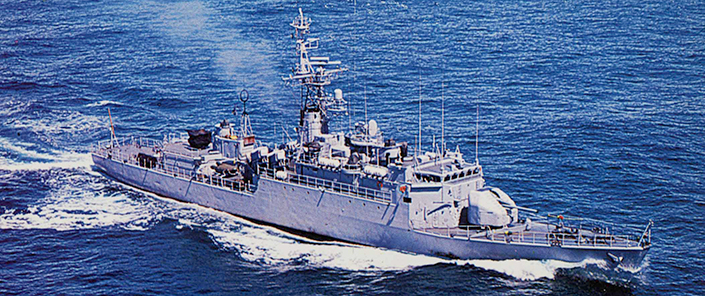
By 9 a.m. the weather had finally cleared enough for the 40 Marines aboard Guerrico to transfer to Bahía Paraiso. Soon after this was done, the ship’s smaller helicopter—an Aérospatiale Alouette III—took off for King Edward Point carrying Lieutenant Guillermo Jorge Luna and six of his Marines. Lt. Mills and his Royal Marines were fully aware that the Falklands had fallen the day before and they were, accordingly, expecting trouble from the Argentine force still occupying Lieth. Out of caution, they occupied the positions around Shackleton House that had been prepared during the previous week. Then at 11:40 a.m., the Alouette came to a hover over the dock at the British Antarctic Survey station. As it rotated in to land, 23-year old Marine Robert Ashton shouted that he had the helicopter in his sights. He was ready to open fire with his 7.62 mm L4A4 BREN light machine gun but Marine John Stonestreet yelled, “Don't shoot!” Ashton assumed that the order had come from Lt. Mills, so he held his fire while Lt. Luna and his men landed from the helicopter and quickly dispersed among the buildings at the point. A few minutes later, a shot was fired by one of the Argentine Marines, beginning the engagement.
As the Royal Marines returned fire, Lieutenant Luna radioed back to the Bahía Paraiso reporting that he was in contact with opposition and requesting the support of the mortar team that was standing by. Barely five minutes had passed since the first wave landed when the mortar team took-off on board the Alouette, and a force of 15 Marines took off on a larger Aérospatiale SA-330 Puma helicopter to reinforce Luna’s team. Lieutenant Alejandro Villagra steered the Puma toward the British Antarctic Survey station, but because the aircraft was equipped with skids, it would need a flat piece of ground to land, so it could not put down near the dock where the Alouette had landed Lieutenant Luna and his men eight minutes earlier. Instead, Villagra brought the big aircraft in over the mined beach in an approach to set down on the station’s helipad. The Puma came in fast and was braking hard with its nose up when Robert Ashton shouted, "What the f*** do you want us to do now?" At 11:48 a.m., when the helicopter was still about 20 feet off the ground, Lieutenant Mills yelled “FIRE!” All at once, the sound of a dozen L1A1 self-loading rifles, a pair L7A2 GPMGs, and a pair of BREN guns echoed across King Edward Cove. One of the Royal Marines even fired a 66 mm rocket at the helicopter from a U.S. made M72 Light Anti-tank Weapon, but it missed. Robert Ashton did not have a shot at the pilot or the co-pilot, so he directed his fire at the port engine and the rotor hub. In a matter of moments, approximately 500 7.62 mm bullets had struck the Puma, heavily damaging it. With hydraulic fluid spraying all over the aircraft, Lieutenant Villagra reacted quickly and steered south across the cove toward the plateau just beyond the whaling station’s cemetery. Despite the fact that its hydraulic system was beginning to fail, he managed to make it to the other side and put the Puma down safely. Six of the Marines on board were wounded by the gunfire—two so seriously that they later died.
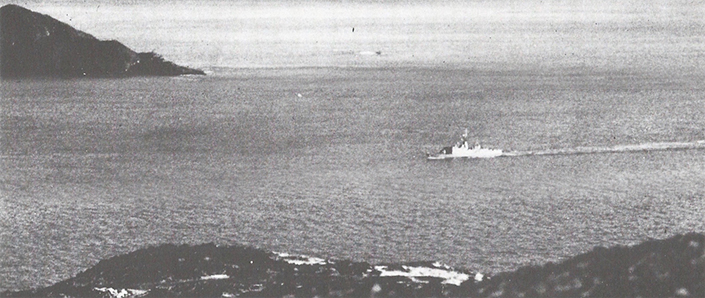
With the Puma down, it was obvious to Lieutenant Luna that King Edward Point was actually a “hot” LZ and that supporting fire would be needed in order to press home the assault. Accordingly, he placed a radio call requesting that Guerrico move in to join the battle. The ship’s commanding officer, Captain Carlos Luís Alfonso responded swiftly, steering Guerrico into the cove and preparing to engage the Royal Marines, but he had to operate at low speed because of the presence of thick kelp patches near the point. Nevertheless, Captain Alfonso crept into position and his crewmen readied their weapons: 20 mm guns mounted on both the port and starboard sides of the ship, a twin 40 mm mount just aft of the bridge, and the ship’s primary armament, a turret mounted 100 mm gun on the forward deck. At 11:55 a.m., the starboard 20 mm gun opened fire on King Edward Point, but it only got off two rounds before malfunctioning. One minute later the twin 40 mm mount opened fire, but it did not manage much better: the left barrel failed after just four shots, and the right barrel’s extractor failed after only five. Then at 11:59 a.m., when the ship was approximately 550 meters from the point, the Royal Marines opened fire. Machine gun fire began striking Guerrico, producing a “pinging” sound that could be easily heard ashore. Bullets shattered the starboard window of the bridge and penetrated the ship’s radio shack. As the gunners on the twin 40 mm were attempting to clear their jams, Marine Steve Parsons had a clear shot at them with his L4A4 BREN gun. He aimed center-mass on one of the crewmen and fired an opening burst, but it fell short. Seeing the splash of the rounds, Parsons elevated his point of aim, and fired again with short, controlled bursts. Bullets from his BREN struck the mount, wounding two and killing Petty Officer Patricio Guanca.

At the same time, the 100 mm main gun fired one round, but then experienced a failure of its loading mechanism as a result of accumulated salt deposits that there had been no time to clean after the ship’s rough crossing to South Georgia. While the gun’s crew struggled to get the loading mechanism running again, one of the Royal Marines fired another LAW rocket that zipped toward the ship at 475 f.p.s. When it hit, the rocket exploded and jammed the turret’s elevation mechanism. Then Royal Marine Dave S. Combes fired a shot from the squad’s other anti-tank weapon: the L14A1 84 mm Carl Gustav recoilless rifle. The shell streaked toward its target at 800 f.p.s., skipped once on the surface of the water, ricocheted into ship’s hull, and exploded with a thud.

As Guerrico passed behind the buildings of the British Antarctic Survey station, the ship was no longer in the Royal Marines’ field of fire. With that, Lt. Mills and his men let out a shout and a cheer for what they had just done. In a matter of seconds, they had fired more than 1,000 rounds that inflicted casualties, and they seriously damaged a once intimidating warship. But their celebration was premature. Bullets zipping through the tussock grass reminded them that there were still Argentine Marines below at the station who were perfectly capable of directing accurate gunfire toward Shackleton House. There was still the small matter of the wounded warship to worry about as well. Shallows on either side of the narrow channel that Guerrico used to approach King Edward Point prevented the ship from maneuvering, and this meant that Captain Alfonso was irreversibly committed to entering the cove. He could not turn the ship around until advancing to the broad turning basin at Grytviken’s waterfront, so he continued ahead with a gaping hole in his starboard side from the Carl Gustav hit. There, the ship was brought to a complete stop as damage control parties went to work and medics began treating the wounded. From a distance of approximately 750 meters, the Royal Marines watched the motionless Guerrico and wondered if it would attempt to escape. Things had not gone well for Capt. Alfonso in the first round, but he was a shrewd-enough naval officer to know that he was trapped, and that passing King Edward Point again was his only way out. A graduate of the Argentine Naval Academy’s class of 1958, he had served previously aboard the cruiser Belgrano, the minesweeper Chaco, and the destroyers Buenos Aires and Rosales, so he was neither inexperienced nor reckless. His decision was a measured calculation. Believing it to be the best course of action, Capt. Alfonso cleared the bridge and gave the order to run the gauntlet one more time.

The men at the point watched Guerrico cautiously and, when a plume of smoke eventually issued from its funnel after just a few minutes, they realized round two was about to begin. The sound of arms being reloaded rattled through the grass as the ship got under weigh, but while almost all of the Royal Marines readied themselves, 37-year old Command Sergeant Major Peter J. Leach left his position and ran into Shackleton House.
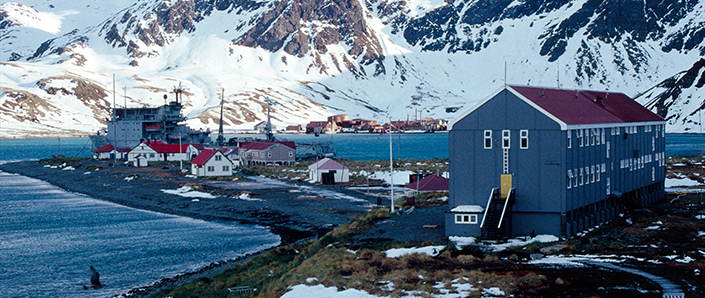
Once inside, he climbed the stairs to the second floor and rushed down the hall to the end of the building facing Grytviken. Then, using the butt of his rifle, Leach broke out the glass of a corner window and dragged a table into the middle of the room. By 1982, he had been in service for 19 years and was a veteran of combat tours in Borneo, Northern Ireland, and Cyprus. At earlier times in his career, he had served as an aerial observer, an aerial photography instructor, and a small boat operator. But, most importantly, Leach was a qualified sniper. In fact, he was reportedly capable of putting a hole in the center of a man's forehead at 1,000 meter. Leach was armed that day with the right weapon for that job: the L42A1 rifle. A conversion of the Lee–Enfield No. 4, Mk. 1(T), the L42A1 was chambered for the 7.62x51mm NATO cartridge and mounted the 3.5X No. 32 scope.

Lying on the table on the second floor, the sergeant major placed the post of his reticle on the approaching ship’s bridge. By then, Guerrico was once again facing the channel and closing on King Edward Point. A moment later, as the other Royal Marines began hammering away at the ship for a second time, Sgt. Maj. Leach began firing carefully aimed shots at the vessel. He directed his opening rounds at the five windows across the front of the bridge. At this point, only Capt. Alfonso, the helmsman, and the quartermaster were manning that station as glass began to shatter. The three men were forced to crouch down behind ship’s structures to avoid being struck by the rapid succession of accurate shots coming from Leach’s sniper rifle.
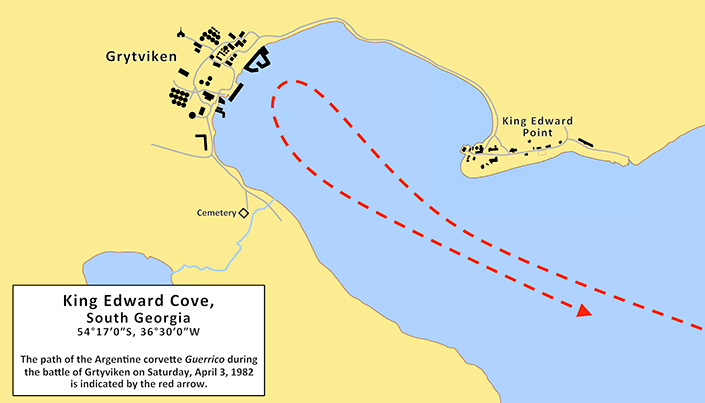
There was a lull in the Royal Marine gunfire as Guerrico moved behind the cover of the buildings of the British Antarctic Survey station, but it did not last long. Sergeant Major Leach, who no longer had a shot, seized that opportunity to move to another position. He broke out another window, and then resumed firing—this time at the three windows on the port side of the ship’s bridge. The sound of shattering glass could be heard once again as Leach dumped more well aimed sniper fire in on the quartermaster, the helmsman, and Capt. Alfonso. Then Guerrico came out from behind the British Antarctic Survey station buildings and the rest of the Royal Marines opened-up once again. They raked the ship from stem to stern with another barrage of automatic weapons fire, and Dave Combes launched a second 84 mm round from the Carl Gustav. That round slammed into Guerrico’s Exocet anti-ship missile launcher, knocking it out of commission. During the last few moments, as the ship retreated out of small arms range, Sgt. Maj. Leach moved to a third window on the second floor of Shackleton House, and threw a few parting shots at Guerrico as it limped past King Edward Point. The ship had survived running the gauntlet, but by then it was listing to starboard, and it looked like a colander. When Guerrico approached King Edward Cove, it was a well-armed and dangerous warship. Not even 15 minutes later, the ship was little more than a floating wreck in desperate need of repairs.
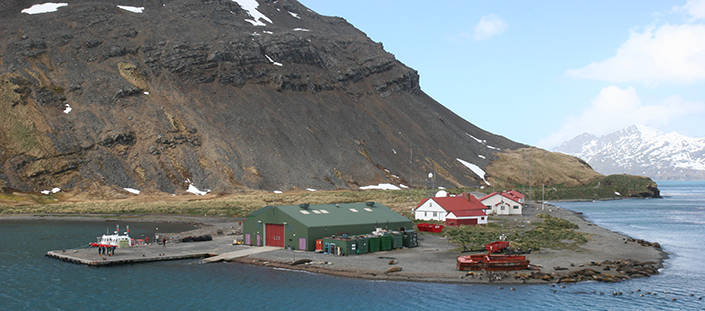
Although Lt. Mills and his Royal Marines had successfully driven off a powerful warship with only light infantry arms, their situation was nevertheless tenuous. During the engagement with Guerrico, the Alouette continued to ferry additional Argentine Marines to the area near the cemetery 1,100 meters across the cove. They could be heard shouting sporadically, and they were even beginning to deliver machine gun fire toward Shackleton House. In addition to that, Lt. Luna’s force of Argentine Marines was still holding on among the buildings of the Antarctic Survey Station. In fact, it was one of Luna’s men who wounded Royal Marine Nigel Peters in the closing moments of the gun battle with the ship. Peters had taken two rounds through the upper arm and was in critical condition. Minutes passed as Guerrico’s crew worked to repair the stoppage in the 100 mm gun’s automatic feed system. They resolved that issue quickly enough, but the turret remained jammed in one position as a result of the M72 LAW rocket hit. Captain Alfonso was determined to get the ship back into the fight and did so by using its engines to aim the immovable turret. At 12:25 p.m., the 100 mm gun began firing at King Edward Point. As the shells began to fall, Sgt. Maj. Leach emerged from Shackleton House yelling for covering fire, and ran over to Lt. Mills to discuss the next move. Knowing that they could not hold out much longer against the Argentine opposition, and that only emergency medical intervention could save Peters, Lt. Mills made the decision to surrender. With that, the Battle of Grytviken came to an end. Mills and his men were transported to Rio Grande, Argentina on board Bahia Paraiso and then eventually flown to Montevideo, Uruguay, for repatriation. They returned to Great Britain on April 20 and reported that they had been well treated by their Argentine captors. South Georgia was recaptured by U.K. forces on April 25 during Operation Paraquet, and the war was over 50 days after that.

Today Grytviken looks almost the same as it did during the war: the old whaling station is still there and the wreckage of Alejandro Villagra’s Puma still sits where it crash-landed in 1982, but Shackleton House was torn down in 2001. Despite that, spent shell casings can still be found in the tussock grass around where the building once stood. After the battle, Guerrico was quickly repaired and returned duty, but some of the damage inflicted by the Royal Marines could not be erased. With bullet holes still scarring it, the ship remains in service to this day. Guerrico’s former captain, Carlos Luís Alfonso, retired from the Argentine Navy as a Vice Admiral and later recalled that, “the events at Gryviken gave each individual the opportunity to appreciate our ability to deal with adversity.” He passed away in Buenos Aires on Nov. 1, 2014. His one-time antagonist, Peter James Leach, on the other hand, is alive and well and living in Liverpool. He was awarded the Distinguished Service Medal for his role in the Battle of Grytviken--a one-of-a-kind action in which a lone sniper turned the tide of battle on a warship.






































